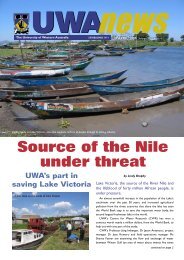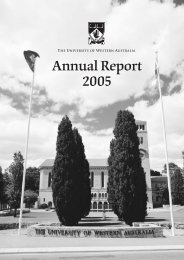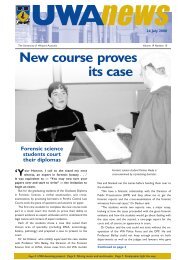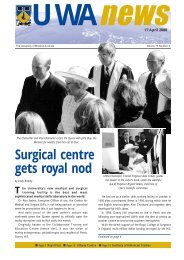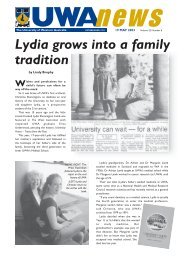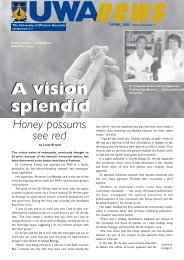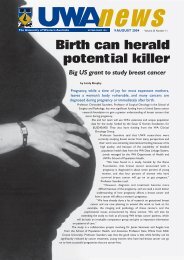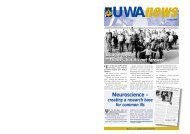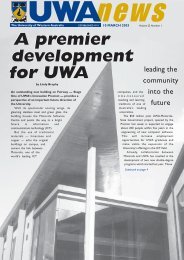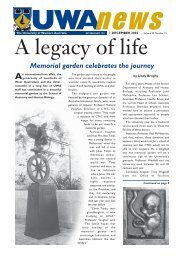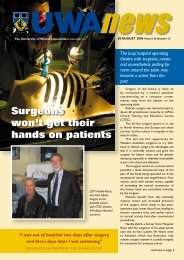22 Aug: Vol 24, #12 - UWA News staff magazine - The University of ...
22 Aug: Vol 24, #12 - UWA News staff magazine - The University of ...
22 Aug: Vol 24, #12 - UWA News staff magazine - The University of ...
- No tags were found...
You also want an ePaper? Increase the reach of your titles
YUMPU automatically turns print PDFs into web optimized ePapers that Google loves.
<strong>UWA</strong>newsGermination discoverya big dealHutch Ranck and Pr<strong>of</strong>essor Alan Robson sign the agreementF a r m e r s a l l o v e r t h eworld should be able,within a decade, to use aseed germination processdiscovered at <strong>UWA</strong> and KingsPark.In a deal described as one <strong>of</strong> themost exciting commercialisationagreements with which the <strong>University</strong>has been involved, international chemicalcompany DuPont has signed a researchdevelopment licence to evaluate andexplore the seed germination technology.Hutch Ranck, Managing Director <strong>of</strong>DuPont Australian and New Zealand, saidhis company could spend up to $US 200million on the project.And Australia’s only Nobel Prizewinningchemist has also taken an interestin the work.Researchers in different parts <strong>of</strong> theworld had been trying for 15 years toisolate the chemical compound in smokethat could germinate seeds. Years <strong>of</strong>hard work by Adjunct Pr<strong>of</strong>essor KingsleyDixon (Kings Park and Plant Biology),Pr<strong>of</strong>essor Emil Ghisalberti (Chemistry)supervising PhD student Gavin Flematti,and Pr<strong>of</strong>essor Robert Trengove (sincemoved to Murdoch <strong>University</strong>) hit thejackpot and, in 2003, the team applied fora patent.<strong>The</strong>ir ground-breaking research waspublished in Science in June 2004.Dr Andy Sierakowski, Director <strong>of</strong> theOffice <strong>of</strong> Innovation and Industry, whohas a background as an organic chemist,admitted that the smoke deal had been apet project for him.“Simon Handford, in OII, has done aremarkable amount <strong>of</strong> work negotiatingthe deal between the researchers andDuPont and thanks must go to him forkeeping me on track,” Dr Sierakowskisaid. “I must have driven Simon crazy, butI was just so excited by the prospects,which are now coming to fruition.”Dr Sierakowski completed apostdoctoral research project in organicchemistry with Nobel Prize winnerJohn Cornforth, and he contacted hisformer supervisor, knowing he would beinterested in the research.“John is also excited about this discoveryand subsequent commercialisation bid, andhe has come up with a couple <strong>of</strong> ideas onwhich some Honours students are nowworking,” he said.Dr Sierakowski said DuPont had beenchosen because the universities needed apartner who had a recognised researchand development capability, access tothe agri-chemical production world, anda seed technology company. It was alsoimportant that DuPont had a good record<strong>of</strong> working with Australian universities.“I had worked in my own agri-chemicalcompany as an organic chemist and Iknew the players in the field, which alsohelped,” he said.At the signing <strong>of</strong> the deal, Pro Vice-Chancellor Pr<strong>of</strong>essor DougMcEachern said having a brightidea, working it through andgetting the science right wasnot the end <strong>of</strong> a project.“We recognise that we, asa university, don’t have theexpertise and capabilities t<strong>of</strong>ollow through this bright idea,and we thank DuPont for taking up thechallenge.”Mr Ranck said the chemical andanalytical skills and the botanic andbiological knowledge <strong>of</strong> the researcherswere world class.“Today is the first step on a journey<strong>of</strong> bio-prospecting. At the end <strong>of</strong> it, wewill be able to replicate one <strong>of</strong> nature’sphenomena and the prospects <strong>of</strong> usingthis compound are truly exciting. But thejourney will take at least five to sevenyears.”As reported in <strong>UWA</strong>news on July 25this year, the compound has the potentialto be used to control weed germinationthat could save Australian farmers billions<strong>of</strong> dollars a year. It could be used togerminate native species without the use<strong>of</strong> fire, thereby saving native fauna. And itcould help with swift restoration <strong>of</strong> minesites by germinating seeds in the topsoil.Dr Andy Sierakowski …a pet projectTHE UNIVERSITY OF WESTERN AUSTRALIA • <strong>22</strong> AUGUST 2005



